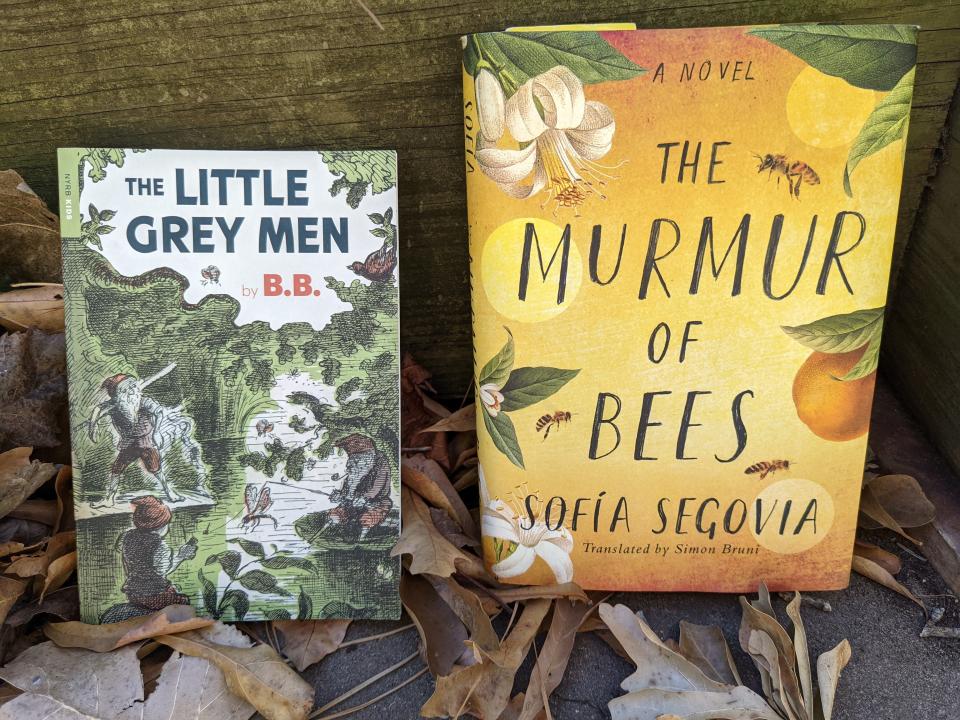Gardens of the Cross Timbers: Bees and Gnomes
If you appreciate the numeral arrangement of 01/22/2022, next month’s 02/22/2022 has a real beat to it. Write a rhythmic song or even your own novel built around significant numbers.
During the doldrums that followed the end of the Yule season, I finished reading two books. One was read in an afternoon on an airplane. The other book was a lengthier novel started in October. A few pages were read each night, interrupted by two trips and Yule celebrations.

The Murmur of Bees (text translation 2015, copyright 2019) is an intense piece of work. The complex novel, translated from Spanish into English, is historical fiction and takes place in Monterrey and Linares in northeastern Mexico. The time frame spans the Mexican Revolution, the ‘Spanish’ influenza pandemic of 1918 and ends in the 21st century. The writer, Sofia Segovia, was born in Monterrey, Mexico, one of the cities often mentioned in the novel.
The story begins with pockets of armed conflicts erupting between wealthy landowners and the agrarians in full swing. Outside Linares, the Hacienda La Amistad, a large ranch run by the Morales family, is staffed by servants and field workers. A mysterious baby appears under a bridge with an active bee hive nearby. Both baby and hive are covered in honey bees. When the bees moved, it could be seen the baby’s face had no upper lip, gums or palate. Many of the superstitious campesinos (peasant farmers) asked that the unlucky child be left to die. Nana Reja, the old wet nurse who had cared for dozens of babies in her prime, claimed and defended the motherless disfigured child. Francesco Morales, owner of the sprawling ranch, supported her and decided the baby would be raised in the ranch family. He became the baby’s godfather. The baby was named Simonopio.
The bees always accompanied Simonopio. The boy, unable to talk legibly, had precognitive insight allowing him to see into the future, although no one knew this except the narrator of the story, Francesco Morales Junior. Junior could understand Simonopio since he spent much time with Simonopio from infancy until he was 7 years old. Simonopio and Francesco Junior developed their own language no one else could recognize, in part because of how Simonopio spoke and how the words sounded. Young junior learned it as another language.
Junior was born just after the flu epidemic had decimated many communities. A quote from page 73, written by the author in 2015:
At the height of the disease, Dr. Sepulveda of the Monterrey Hospital and Governor Zambrano requested public places to be closed and to stop all travel. “The request fell on deaf ears……The miracle would have been if those arrogant fools with the fate of the country in their hands had listened in time to the voices of the experts. Now it was too late.” Flu deaths in Mexico may have ranged between 300,000 and 500,000. As a result, communities had to be restructured, but life continued.
Dissatisfaction among the agrarians stirred trouble. Large ranches and owners with perceived immense wealth were being dissected and given to the agrarians. The Morales ranch changed direction from growing large tracks of sugarcane, subject to governmental division, to planting orange trees in more unproductive areas. This assured the land was being used and less likely to be taken over by the government. With the help of Simonopio and his bees, the orchards changed the future of the Morales family and their household.
The tone of the book is dramatic, but the bees add a richness and appreciation of the land and its nature, unappreciated by most except Simonopio.
A light-hearted read, “The Little Grey Men”, is a little nature hike through England with gnomes. Written and illustrated in 1942 by B.B. (1905-1990), the children’s fantasy novel was written for ages 8-12. I first heard about this story while listening to a Julie Andrews interview. Her father bought her a copy when she was eight years old. She fondly remembered the story not only for the escapades of three gnomes while they searched for their lost brother, but the lavish descriptions of nature through four seasons.
Well, a book which was Julie Andrew’s favorite kid book piqued my interest. Somewhere in the middle of England (Warwickshire), at the base of the roots of an oak tree near Folly Creek lived possibly the last three gnomes alive. They were no taller than a rabbit. These are not your present day well-fed, brightly clad brainless gnomes, but wizened tiny men of indeterminate age.
The old gnomes had ruddy red complexions, covered in long hair, ears long and pointed, clothing was made of mouse skin, snake skin or moleskin, and two sported beards. All walked barefoot. A plan was hatched to find a fourth gnome that had gone exploring years before but never returned home.
Tranquil settings, harrowing events and an abundance of wildlife fill each page. The seasons transition from one spring to the next as the gnomes cope with rains, scant moisture, heavy snow, ice, and balmy to frigid temperatures while on their journey. The vehicles they create are constructed from leaves, woods, skins and other natural sources until they discover the boat.
After finishing this little paperback with some cool illustrations, I could only hope there were still parts in England still as the author described from decades ago. The 1948 sequel “Down the Bright Stream” is a continuation of the adventures of the gnomes after their home is flooded. They wind up in Ireland.
A prequel was written years before, “The Forest of Boland Light Railway”, follows another group of gnomes who build a narrow-gauge railway to carry the ore from their gold mining operation. Wicked goblins and friendly elves surface in the story.
Love nature? Listen to the Bees or take a trip with the gnomes!
This article originally appeared on The Shawnee News-Star: Gardens of the Cross Timbers: Bees and Gnomes

